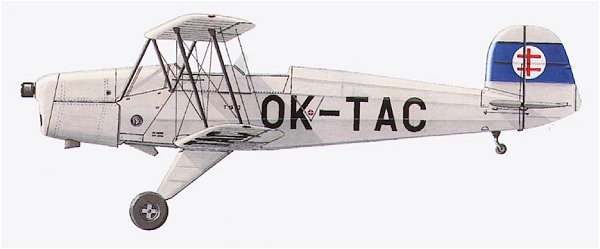Tatra T-131
|
|
- two-seated school, training and sporting aircraft
- origin: Czechoslovakia / Germany
- built: 1936
- wingspan/length/height: 7,40 / 6,76 / 2,25 m
- take-off weight: 680 kg
- range: 650 km
- ceiling: 5200 m
- Tatra T-100 powerplant with max. output 105 HP
- airspeed maximum/landing: 185 / 82 km/h
|
From 1934 year Czechoslovak firm Tatra started to pursue
the aircraft production and the construction of aircraft engines. As a reasonable
start was considered a licence production. At the same time of licence production
there was in progress also the development of their own constructions such as
T-001, T-101 or series produced T-201. In that time very popular and successful
German Hirth HM504 engine became the template for the Tatra's replication marked
as T-100. The licence production was ensured by the construction of successful
training and sporting aircraft Bü 131 Jungmann marked as T-131. This machine
was identical as its example, some differences were only in T-100 engine that
had several modifications. The construction of fuselage was from aluminium tubes
covered by fabric (in front part covered by tin), undercarriage was fixed. The
seats were situated one behind one in open cockpits. There were totally produced
35 machines of T-131 between 1936 and 1939.
Original Bü 131 came into existence in Germany in 1933 year.
It made its maiden flight in 27.4.1934. Initial customer was Deutscher Luftsportverband,
one year later also Luftwaffe put them to its enginery as a school aircraft
for basic training. They served in Luftwaffe till the end of the war and after
their discarding from flying schools were fitted in to some Nachtschlachtgruppen
NSGr.2, NSGr.11 or NSGr.12. Its excellent flying performances caused expansion
to the foreign. Even it got to the Japan, where it was flying in the army as
Ki-86 "Cypress" and in the navy as K9W1.
T-131 in Slovakia
Aircraft T-131 was produced as a Tatra's licence
of original German Bücker Bü 131 in Czechoslovakia. Ten machines made in 1936
took the Ministry of National Defence and split them to the particular flying
clubs all over the Czechoslovakia. One aircraft with serial number 2 got to
Slovakia in 1936 year, tangibly to the Slovak Flying Club in Vajnory. After
the breaking of Czechoslovakia and the origin the independent Slovak state it
was took over by the Hlinka Guard to its state and later the Slovak Flying Corp
(SLeS) where it was flying till its crash in 1940. After its reparation in workshops
of the Aircraft Park in Trenčianske Biskupice it served again in SLeS till April
1943 when it flew again to Trenčianske Biskupice for the revision of the engine.
But the revision did not realized due to the lack of spare parts and machine
was canceled in the same year. In the service od SLeS it was used for training
and acrobatic purposes in the practise of pre-military breeding.
Sources:
[1] Juraj Rajninec - Slovenské letectvo 1939 - 1944, 1. zväzok
[2] Ing. Ivo Sklenář, Ing. Jiří Sklenář - Rekordní Tatra T-101, L+K 15/1993
[3] Marek Murawski - Letadla Luftwaffe, časť 1
Photoarchive:

